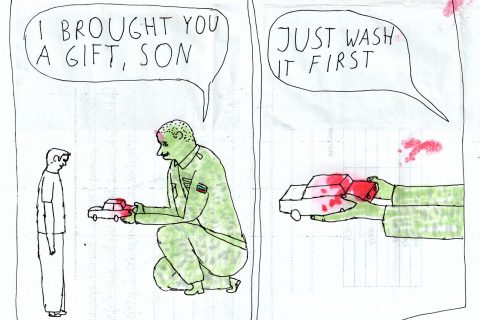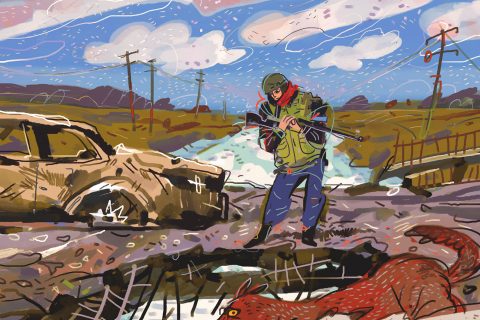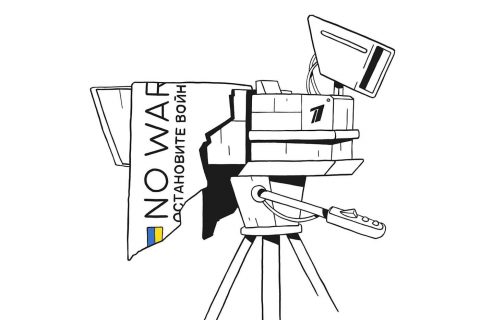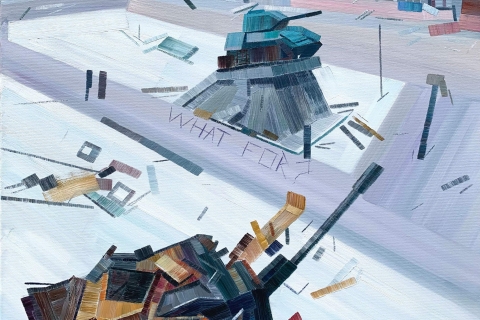
Roman Minin’s Dreams of War
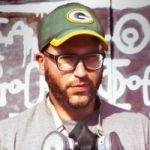
A monumentalist painter, graphic artist, photographer, and author of art objects and installations, he participated in international art projects and organized street art festivals. Also, he co-managed the Art Embassy non-profit and the Transmonument startup. During the war, he moved from Kharkiv to Lviv.
— I was born in the city of Dymytriv and lived there until the age of 16. Now it’s Myrnohrad. It is located 40 kilometres away from Donetsk. I used to visit Donetsk now and then and remember its heat and dust, stuffed buses and trams, and soft asphalt.
I have pleasant memories of Donetsk. For one, my parents bought me oil paints at a shop on Pushkin Boulevard there in 1993. This is how I fell in love with painting. However, there are a lot of unpleasant things to remember, too. I remember how my solo exhibition slot was given to another artist. I remember how the regional administration closed my exhibition because miners found my paintings offensive. My art career didn’t seem to work out in Donetsk, which is no wonder because it’s hard to work in the scorching heat in summer and freezing cold in winter. Besides, the cult of sacred sacrifice dominated the steppes of Donetsk, meaning that it took suffering to earn respect in society — if the society was willing to show the respect at all, that is. Therefore, I was happy to leave for Kharkiv to study.
My art career didn’t seem to work out in Donetsk, because it’s hard to work in the scorching heat in summer and freezing cold in winter.
Sometime in December 2009, I had a very realistic dream. In that dream, I sewed myself a suit from foil and glass wool, which was supposed to make me invisible to the strange things flying over my house (I didn’t know that drones were a thing at the time). I put that suit on and slowly crawled from the basement of one house to another to look for food in the flats there. Those strange things identifying people with thermal cameras were flying over me all that time. I woke up and was overcome by happiness and relief that it was just a dream.
After this horrible and, as it turned out to be, prophetic dream, I set aside all my plans, took my Kyiv 6S medium-format camera and some film rolls, and went outdoors to enjoy a peaceful day. I wanted to document the calmness and happiness of life. In the evening, I developed the film myself, dried it, and started drawing on it the associations that enhanced the reality. In modern smartphones, it is called AR, and at that time, I created it myself, drawing images with sharpies. I didn’t have a scanner and didn’t know how it would turn out. I had to pay my last money to scan the rolls in a photo studio. This is how my Dreams of War series came to be. To me, those are not photographs, but rather experimental art pieces, the beginnings of the augmented reality and intertwining of media we now see.
I felt the impending war in everything: jokes, the stories people told, the hate toward the alleged Banderites that some miners harboured. The attitude was shaped from the very childhood at celebrations, in garages — everywhere the miners could discuss their actual values. I suspected that the picture of the world could be different, and the mentality differences were artificially created to justify something horrible, like war.
I felt the impending war in everything: jokes, the stories people told, the hate toward the alleged Banderites that some miners harboured.
My mum often criticizes me for undervaluing myself. It’s so sweet of her. However, I always subject my thoughts, ideas, and desires to a crash test of sorts. Since my childhood, I felt the world was enormous, and there were genius people in it, compared to which I was ignorant. This feeling taught me not perfectionism but uniqueness. I cultivated in myself the aspiration to create unique art pieces like no other. Granted, I don’t always succeed. It takes seeing a lot and visiting many places, after all. Having been to a bunch of countries, I could look at the situation in the Donetsk Region from a different angle. I realized that the forced attitude was a small peephole which didn’t let one see the entire world. It’s for this reason, perhaps, that the people in the Donetsk Region who have never left their land have no worldview whatsoever and are so easy to manipulate. All you need to do is find their point of view, which is often also their proverbial button, which can be pushed when the time is right. Also, this understanding of the mentality and my intuition told me that something terrifying was approaching. I knew that a big war was coming.
I don’t know if one can train their intuition. It’s the ability to see yourself from afar in the context of space and time. However, I believe that the artists shouldn’t necessarily have intuition because mine turned against me. I made many art pieces about the war and its preconditions way before it broke out. And now, society as if demands an appropriate reaction from me as an artist. However, I said everything I had to say. The only thing that worries me now is potential nuclear war. I fear that the current events are just the beginning of global horror. And I’m not ready for it at all.
I very much wish that all this turned out to be a dream — just like the one I had in 2009. I wish I could just wake up from this terror. We remained in Kharkiv for 10 days and then evacuated to Lviv, unable to bear what we experienced. I left all my film rolls in Kharkiv. I don’t know what will happen to them. I become disappointed in the material and increasingly prefer digital. It saddens me to have been unable to take everything I valued and cared about. After all, warm clothes and food are more important when you evacuate. I will probably never work with film again.
I will remain disappointed for a long time still in how helpless the artists are in that art takes too long to create, because art is needed here and now during the war. Therefore, the best kind of art in this situation are memes, short videos, and songs. Other genres will have to wait until the peaceful time.
The artists of all times were in the service of the system, propaganda, and religion. There were some exceptions, but even they advertised the level of freedom that eventually became a religion of sorts. When it comes to fighting propaganda, it’s the dirty work involving those partisan to this propaganda. The ambiguity in art always piqued my interest. I wanted to create not agitation posters, but mirrors where everyone could see themselves. Even now that I compose songs and music videos in support of Ukraine, I’m trying to make not agitprop posters, but amazing and profound works of art. It’s hard because people overcome with social stress have no time to think. However, I know that it takes time to understand art pieces like these. This is precisely the case with my Dreams of War series, which gained relevance only 12 years after its creation.
I wanted to create not agitation posters, but mirrors where everyone could see themselves.
It is the person’s, or artist’s, will that determines their role during the war. Artists can gain popularity during the war and later convert it into power and money. Many show their aptitude for conformism now. The wave of hate brings third-rate imagery to the surface. Large ships take in their sails amid such waves and make every effort not to tip over. I have taken in mine, but I believe good weather will eventually come.
Needless to say that artists can do charity work during the war — this is what I do. It’s great when artists can let their imagination run wild and come up with a future worth fighting for. It’s great when artists can enter the global scene and show all our horrors to the people who might not understand but are willing to help stop them. It’s great when artists redefine their values instead of mimicking the art of faraway countries and turn their attention to our heritage, which the Ukrainian military and civilians are dying for. It is about time we reinvent what we hold close and dear.
New and best
